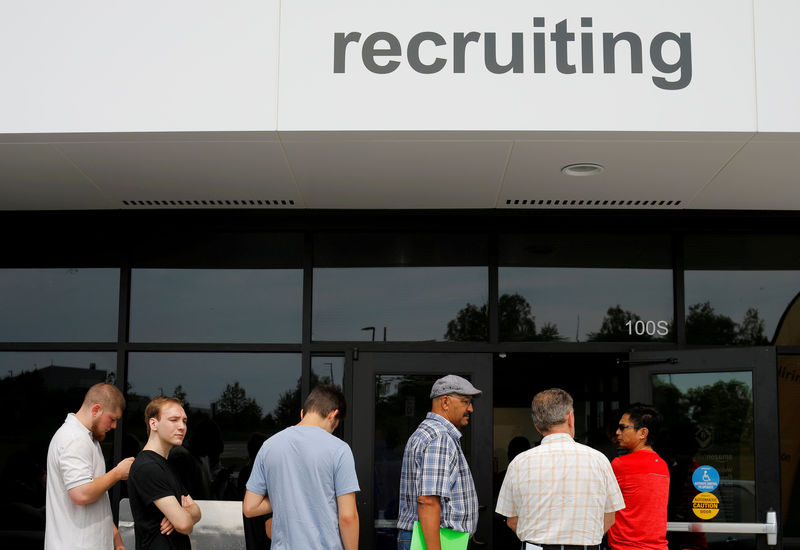By Lucia Mutikani
WASHINGTON (Reuters) - U.S. job growth accelerated in May and the unemployment rate dropped to an 18-year low of 3.8 percent, pointing to rapidly tightening labor market conditions, which could stir concerns about inflation.
The closely watched employment report released by the Labor Department on Friday also showed wages rising solidly, cementing expectations that the Federal Reserve will raise interest rates this month and boosting the probability of two more hikes later in the year. It renewed fears about the economy overheating.
"The strength of the labor market supports our forecast for the Fed to raise rates three more times this year," said Ryan Sweet, a senior economist at Moody's Analytics in West Chester, Pennsylvania. "The Fed is going to get antsy that the labor market will blow too far past full employment."
Nonfarm payrolls surged by 223,000 jobs last month as warm weather bolstered hiring at construction sites. There were also big gains in retail and leisure and hospitality payrolls. The economy created 15,000 more jobs than previously reported in March and April.
Last month's one-tenth of a percentage point drop in the unemployment rate pushed it to a level last seen in April 2000. The jobless rate is now where the Fed forecast it would be by the end of this year.
Average hourly earnings rose eight cents, or 0.3 percent last month after edging up 0.1 percent in April. That pushed the annual increase in average hourly earnings to 2.7 percent from 2.6 percent in April.
The strong employment report added to a string of upbeat economic data, including consumer spending, industrial production and construction spending, that have suggested economic growth was regaining speed early in the second quarter after expanding at a moderate 2.2 percent annualized rate in the January-March period.
The Atlanta Fed is forecasting gross domestic product rising at a 4.8 percent pace in the second quarter. The strength comes even as the stimulus from a $1.5 trillion income tax cut package and increased government spending is yet to be felt.
But there are dark clouds on the horizon. A decision this week by the Trump administration to impose tariffs on steel and aluminum imports from Canada, Mexico and the European Union has renewed fears of a trade war, causing financial market volatility. Trouble has also been brewing in Europe.
Some economists believe the political tensions in Europe and a protectionist domestic trade policy could dissuade the Fed from taking a more hawkish stance when policymakers meet on June 12-13. Traders, however, raised bets for four rate hikes this year.
The U.S. central bank lifted borrowing costs in March and forecast at least two more rate increases for this year. Inflation is running just below the Fed's 2.0 percent target.
U.S. Treasury yields rose and the dollar gained versus a basket of currencies. Stocks on Wall Street were trading higher.
BROAD JOB GAINS
Economists polled by Reuters had forecast nonfarm payrolls increasing by 188,000 jobs last month and the unemployment rate steady at 3.9 percent.
Monthly job gains have averaged about 179,000 over the last three months, more than the roughly 120,000 needed to keep up with growth in the working-age population. Though the labor market is viewed as being close to or at full employment, there is still some slack remaining.
The labor force participation rate, or the proportion of working-age Americans who have a job or are looking for one, fell to 62.7 percent last month from 62.8 percent in April. It has declined for three straight months.
Still, the labor market is getting tighter. A broader measure of unemployment, which includes people who want to work but have given up searching and those working part-time because they cannot find full-time employment, fell to 7.6 percent last month, the lowest since May 2001, from 7.8 percent in April.
With job growth expected to slow as employers struggle to find qualified workers, economists expect wage growth will pick up significantly. There is growing anecdotal evidence of worker scarcity.
A report from the Fed this week showed shortages of truck drivers, sales personnel, carpenters, electricians, painters, and information technology professionals.
"As labor becomes increasingly scarce, we expect to see further strengthening in average hourly earnings," said John Silvia, chief economist at Well Fargo Securities in Charlotte, North Carolina.
Job gains in May were across all sectors. Construction payrolls increased by 25,000 after rising by 21,000 jobs in April. A separate report from the Commerce Department on Friday showed construction spending surging in April.
Manufacturers added another 18,000 jobs last month on top of the 25,000 created in April. Further gains are likely, with a survey from the Institute for Supply Management on Friday showing a pickup in factory activity in May.
The survey suggested manufacturers, especially in the food, beverage and tobacco product industries, were starting to run into labor supply issues. There were also complaints about soaring prices, partially brought about by the steel tariffs.
Government payrolls increased by 5,000 in May, reversing April's 3,000 drop. Retailers boosted employment by 31,100 jobs last month. Employment in the leisure and hospitality sector increased by 21,000 jobs.
